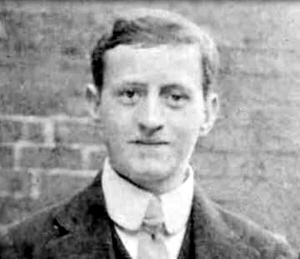
34880, South Staffordshire Regiment, 1st (Garrison) Battalion
Thomas Pyrah Godley was born in Crook, Co. Durham in 1897, the son of Arthur Godley and Lydia Ann (nee Pyrah) who had married on the 22nd of December 1894 at Holy Trinity Parish Church in Ossett. Arthur Godley (23) lived in Bank Street, Ossett and worked as a dyer and his bride Lydia Ann Pyrah (22) lived in Town End, Ossett.
In 1911, the Godley family were living at 23, Queen’s Terrace, Ossett and Arthur Godley was a dyer’s labourer for a mungo manufacturer whilst his wife Lydia was a rag sorter. Thomas Godley was still at school and he now had a six year-old sister Mabel Godley. Also living with the Godleys in 1911 was Ann Pyrah, Lydia’s mother and a niece, Alice Ann Pyrah (15).
The 1st Garrison Battalion of the South Staffordshire Regiment was formed at Lichfield in January 1917 and was subsequently sent to India. Garrison battalions often contained men who were not considered fit enough for front line “fighting” battalions, or who had recovered from wounds but were not really fit enough to return to the trenches. However, many garrison men did see action.
Thomas Godley’s battalion was part of 6th Poona Divisional Area, having arrived in India during May 1917 and joining the unofficially named ‘Bombay’ Brigade, it served in the Bombay area during both 1917 and 1918. The division was commanded by Major-General W.C. Knight. Until 1917 very little of note took place in the area, apart from supervising the transit of troops through the port of Bombay to various theatres of war. In June 1917, 6th Poona Divisional Area was renamed the Poona Division. The Bombay Brigade was responsible for military ‘stations’ at Ahmedabad, Baroda, Bombay, Colaba, Dadar, Deolali, Nasik, Rajkot and Santa Cruz.
Private Thomas Godley died of sickness on the 18th February 1918 aged 21, the son of Arthur and Lydia Ann Godley, of 25, Queen’s Terrace, Queen St., Ossett, Yorks. No service record survives and he only appears to have been posthumously awarded the British Medal. The requirement for the award of the Victory Medal was to have entered a theatre of war. India, with the exception of some border areas, was not regarded as such and therefore Private Godley wouldn’t be entitled to receive the Victory Medal.
Private Godley died of smallpox, an unusual cause of death for a British soldier, but possibly an endemic disease in India during WW1. The “Ossett Observer” 1 had this report of Thomas Godley’s death:
“Official news has been received of the death from smallpox of Private Thomas Godley of the K.O.Y.L.I. whose parents reside at Queen’s Terrace, off Queen Street, Ossett. The young soldier had been in the army about two years and had previously suffered from malarial fever. He used to be employed by a local printer and prior to that was for sometime a tradesman’s errand boy.”
Private Thomas P. Godley is buried at plot VIII B. 17 at the Sewri Cemetery 2 near Bombay, India. Sadly, this cemetery is no longer being maintained and, as an alternative, WW1 soldiers who are buried at Sewri are remembered on Face D of the Kirkee 1914-1918 Memorial, near Poona. Kirkee, also known as Khadki, is a Military Cantonment adjoining the large university town of Poona on the Plateau above Bombay.
References:
1. “Ossett Observer”, 23rd March 1918